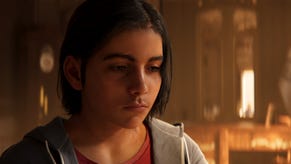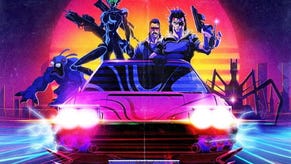Tropical trolling: crazy talk with Far Cry’s Keen
Far Cry 3’s lead game designer, Jamie Keen, talks to Stace Harman about the rational thinking behind the title’s bat-crap crazy events and characters.
As I make my way to the Eurogamer Expo press area, I pass: a young couple canoodling as they wait in line to slake their thirst for bloody violence, a man sat alone in a cordoned-off area flailing his arms at a TV screen, and a six foot, overweight Pikachu.
Arriving at my destination, I’m ushered into a room to talk to two gentlemen about the fifth-but-third title of a franchise and about how they captured the authenticity of an era 250 years past for the creation of a 21st century collection of light and sound.
And after that, I sit down with Far Cry 3’s lead designer, Jamie Keen, to talk about perception of reality and borderline insanity in Far Cry 3.
We sit side by side on a small sofa (there are no more rooms to be had). Just as we are about to begin, a door off to our left opens and out files half a dozen models clad in red lycra hot pants with QR codes printed on their buttocks.
Since we’re evidently saturated by it, it seems prudent to ask Keen where the inspiration and source material for the team’s take on the surreal and the unhinged has come from.
“This is going to sound a bit weird, but I think that we draw a lot on our own experience,” Keen reveals and I shift back a few inches in my seat before asking him to continue.
“The danger of broaching the notion of insanity in a game is that you go over a lip and end up with just full-on crazy and that’s not what we’re looking for with it.
“There’s a particular feeling we’re trying to get across, which is that sinking feeling that you sometimes get in the pit of your stomach as you realise ‘Oh no, this isn’t what I thought it was’ and it’s to replicate those times when you go into a situation and you think it’s all good and all happy and then there’s a switch where you suddenly realise there’s something terribly, terribly wrong going on.”
"You can appreciate that feeling of everything being wonderful and then you take a wrong turn down a street and all of a sudden you’re way out of your depth and things have gone from great to very dark. That’s the feeling that we want."
I think about the different degrees of that feeling: smiles fading on a night out as it’s intruded upon by a drunkard looking for a fight, the creeping dread of being hopelessly lost while backpacking alone in India, the sickening lurch of temporarily misplacing a very young family member in a crowd; these are not pleasant feelings, but they are certainly relatable.
“We want Jason to be familiar,” Keen continues. “We want there to be things within him that you find recognisable so that you can appreciate that feeling of everything being wonderful and then you take a wrong turn down a street and all of a sudden you’re way out of your depth and things have gone from great to very dark. That’s the feeling that we want ... it’s all about reinforcing the feeling that this is happening to you or that it could happen to you and asking you how you deal with that.”
The locals be crazy
So far, Far Cry’s primary lightening-rod for insanity has been one or two particularly off-kilter characters. These characters have thrown-up two diverse, but equally unhinged personalities. The first is Dr Earnhardt, who appears as someone who’s not quite all there, but seems harmless enough.
Early on, it becomes clear that Earnhardt believes a friend of Jason’s to be someone she is not; possibly his absent daughter to whom something bad most likely happened. This revelation isn’t treated as a big reveal, instead it is acknowledged with just a few words between Jason and his friend Daisy as they attempt to deal with the wider, more pressing and overtly dangerous situation.
“People’s realities and what everyone carries around in their head can be wildly different,” Keen explains. “Everyone has their own weird, little world that they’re carrying around with them; it’s just that for some people it’s more extreme than others.
“With Earnhardt, we really wanted this character that’s reasonably cognizant and seems to be fairly benign and then you find out, almost mid-conversation, that he’s living in this completely different reality. That’s blend that we want, that there are certain levels on which you can interact but just don’t dig any deeper because it can get really messy, really quickly.”
This sentiment applies very directly to the more volatile character, Vaas. Thanks to a well-written script and a stand-out performance by actor Michael Mando, Vaas is portrayed as someone who is dangerous to be around, even if you’re supposedly on his side.
“The thing with Vaas is that he can come across almost as nice, sometimes,” says Keen. “But that makes it all the worse because you know that at any moment he can just flip and turn into something different.”
Little is known of Vaas’ origins and so I indulge my imagination, peppering Keen with questions on his origin: was he born on the island, did he come to it in a similar way to Jason, will Vaas’ history and the reason that he is the way that he is be explained through the narrative? Keen pauses before answering.
"The thing with Vaas is that he can come across almost as nice, sometime. But that makes it all the worse because you know that at any moment he can just flip and turn into something different. There’s a lot of stuff that we’re leaving up to the player to notice and bring their own judgement to and form their own opinions of."
“There’s a lot of stuff that we’re leaving up to the player to notice and bring their own judgement to and form their own opinions of,” he offers cautiously.
“There’s going to be a lot of stuff that happens in the story and out in the world that we’re not necessarily going to tie up with a big bow because it’s a really powerful thing when players start bringing their own imaginations to the table and using their own idea of what’s going on, so it’s about trying to pull people into the story and the world to enable them to do that.
“It gives it a personal twist and it speaks to some people more than others, and so the things that I find really harrowing and shocking in the game or storyline might not be the same things than others do, it’s about that personal feeling which means that not everyone will have the same experience.”
As the PR signals that we have time for just one more question, I realise how quickly the time has flown and how interesting a discussion can be had about the nature of reality and perception. I decide to take a punt and instead of asking a question, I make a statement.
I tell Keen that I really like the idea that with all the stuff that happens to Jason on this island and with everything that he has to deal with, his own perception could be distorted enough that he could end up a lot like Vaas; that he could even be the next Vaas.
Keen smiles, “Question mark,” he says with a laugh, and with that I’m thrust back into the peculiar reality of the show floor.
Not long after, I’m stood in line for food while, ahead of me, Solid Snake orders burger and chips. Later that night, my train journey home involves a well-dressed, middle-aged gentleman having an intense conversation with himself. Everyone has their own “weird, little world”, indeed.









